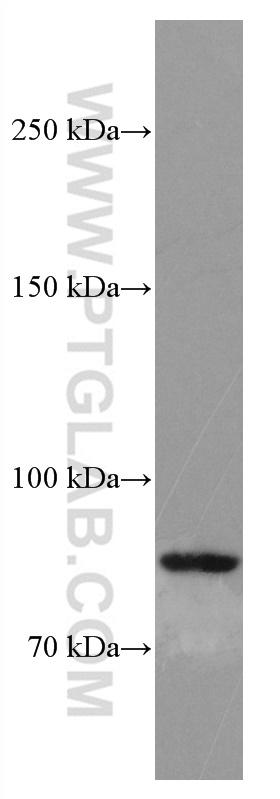验证数据展示
经过测试的应用
| Positive WB detected in | MCF-7 cells |
推荐稀释比
| 应用 | 推荐稀释比 |
|---|---|
| Western Blot (WB) | WB : 1:1000-1:6000 |
| It is recommended that this reagent should be titrated in each testing system to obtain optimal results. | |
| Sample-dependent, Check data in validation data gallery. | |
产品信息
66874-1-Ig targets SMYD4 in WB, ELISA applications and shows reactivity with Human samples.
| 经测试应用 | WB, ELISA Application Description |
| 经测试反应性 | Human |
| 免疫原 | SMYD4 fusion protein Ag11552 种属同源性预测 |
| 宿主/亚型 | Mouse / IgG1 |
| 抗体类别 | Monoclonal |
| 产品类型 | Antibody |
| 全称 | SET and MYND domain containing 4 |
| 别名 | KIAA1936, SMYD4, ZMYND21 |
| 计算分子量 | 804 aa, 89 kDa |
| 观测分子量 | 85-89 kDa |
| GenBank蛋白编号 | BC035077 |
| 基因名称 | SMYD4 |
| Gene ID (NCBI) | 114826 |
| RRID | AB_2882208 |
| 偶联类型 | Unconjugated |
| 形式 | Liquid |
| 纯化方式 | Protein G purification |
| UNIPROT ID | Q8IYR2 |
| 储存缓冲液 | PBS with 0.02% sodium azide and 50% glycerol , pH 7.3 |
| 储存条件 | Store at -20°C. Stable for one year after shipment. Aliquoting is unnecessary for -20oC storage. |
背景介绍
SMYD4, also named as SET and MYND domain-containing protein 4, is a 804 amino acid protein, which contains 1 MYND-type zinc finger and 1 SET domain. SMYD4 belongs to the class V-like SAM-binding methyltransferase superfamily. SMYD4, as a potential tumor suppressor, plays a critical role in breast carcinogenesis at least partly through inhibiting the expression of Pdgfr-alpha, and could be a novel target for improving treatment of breast cancer. SMYD4 is a muscle-specific transcriptional modulator involved in development.
实验方案
| Product Specific Protocols | |
|---|---|
| WB protocol for SMYD4 antibody 66874-1-Ig | Download protocol |
| Standard Protocols | |
|---|---|
| Click here to view our Standard Protocols |
